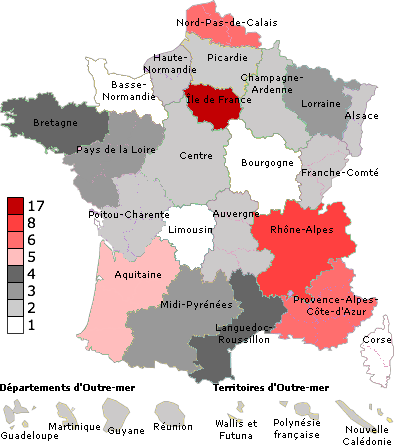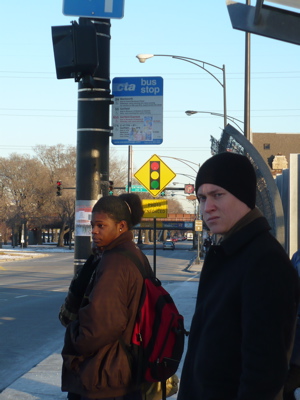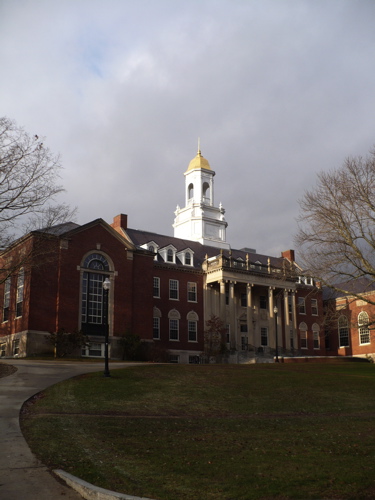The University of Paris-X at Nanterre is now just called Université Paris Nanterre. I went there this week to poke around in the archives of my fieldsite. On the way to the library I stopped to find something to eat, and it turned out that the nearest campus eating establishment was an ethnographically useful site. Admittedly, I am getting somewhat out of practice as a campus ethnographer, but I still noticed a few things.
Tag: academic space
Bourdieu on UC Santa Cruz
I just came across Pierre Bourdieu’s curious comment on American universities and their set-apartness from society:
Philosophers without infrastructure, Part 2
Following up on my last post (and indirectly on a couple of older posts), I came across an interesting interview extract that comments in a bit more detail on the lived experience of being a philosopher with practically no work infrastructure. Here’s a philosopher from Paris 8 commenting on his workspace:
Professor: “I don’t think I’m giving you any scoop in saying that, on the material level, the Philosophy Department is the poorest one in the country. It’s clear — it’s very clear, even. When, for instance, young colleagues were arriving after I got here — at the moment I’m thinking of Renée Duval who sent me a message asking, so, where was her office [Laughter] although she didn’t have an office. And, you know, even at Paris 7, if you want to meet, I don’t know, Frédéric Gauthier, I say Frédéric Gauthier because we know each other pretty well, so, indeed, he will make an appointment with you in his office.”
A department secretary interrupts: “Still, they don’t have their own offices, they have a shared office for teachers.”
Professor: “Non non non non non non non. Gauthier, he has an office, and there are other offices. At most, they’re two to an office. Of course! No, here, it’s on the edge.”
Secretary: “Yes, it’s on the edge.”
Professor: “Yes, here, it’s borderline scandalous. Meaning that, for example, we wouldn’t have to be meeting here [in the staff office space].”
Secretary: “Mais non, I agree with you.”
Professor: “Mais oui. And, well, there’ll be an office, we would be in the office, indeed, we could both of us shut the door. So for example, the master’s thesis exams happen here [in the staff office space].”
Me: “Really, they’re here?”
Professor: “Yes, it happens — and so people who show up, we can’t prevent them, it’s the office — where they turn in their homework, where they come for information, but, still, it’s scandalous. The first year, when I came, throughout practically the whole first year, I spent the first twenty minutes of class with the students looking for a room. It’s since been stabilized, but—“
Continue reading “Philosophers without infrastructure, Part 2”
Geographic centralization of French universities
It is a famous, even infamous fact about French universities that the system is deeply centralized, and centered on Paris. But over the years the university system has diversified and there are now 83 French public universities (of which 5 are in Corsica and the overseas territories). However, as every French academic would surely attest, the system remains deeply Paris-centric. For the foreign reader, I thought it would be helpful to present a little map of the density of universities by region (based on this original):
Continue reading “Geographic centralization of French universities”
Universities on strange premises
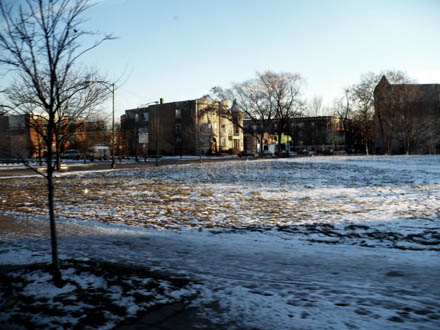
It has slowly dawned on me that a huge number of universities came by their premises, by which I don’t mean their philosophical axioms but their physical environments, in exceedingly peculiar ways. Some of what follows below is hearsay and I don’t really have time to do historical research. But there’s more odd variation here than one might have predicted.
- The Danish School of Education occupies a building that, I’m told, was during World War II the Nazi museum of Scandinavian folk cultures. (This apparently had something to do with creating an Aryan heritage, though I gather that Germans at the time were hard pressed to pass themselves off as more Aryan than the Scandinavians!)
- Cornell University: Was once a farm (albeit financed by the massive business success of Western Union’s telegraph operation in the 1850s). University of Connecticut: likewise was once a farm.
- The University of Paris-8 used to be in Vincennes but was forced to move to Saint-Denis in 1980, and all its original buildings were demolished on the government’s pretext that it was a den of drug dealers (according to a film I saw).
Militant student slogans and iconography in Toulouse
Last week while I was in Toulouse, I went to take a look at the local university (Mirail), to see if it turned out to be the one in the video I posted about last week. And indeed there were a large number of decrepit buildings, occasionally graced by lovely flowers. But the buildings also turned out, like Paris-8, to display an intense activist visual culture: of graffiti, of slogans, of icons, of murals, of messages that contradicted each other, of clashing color.
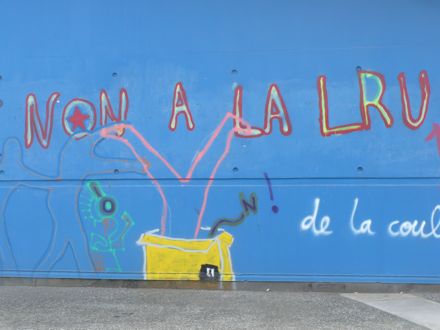
No to the LRU! says a figure falling into a trash can. Or is it the LRU itself that’s falling into a trash can?
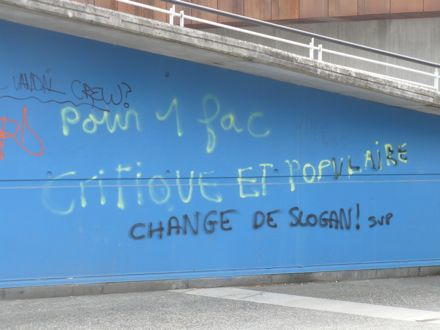
“For a critical and popular university [fac]!” Apparently this is a traditional militant slogan at Toulouse.
“Get a new slogan please!” is the caption written below by someone who apparently disagrees or is simply bored.
[La fac, i.e. la faculté, is a now bureaucratically obsolete term that used to designate a college, a faculty, a division – as in the Faculty of Arts, the Faculty of Law, etc. It is still used in common parlance to refer to the public universities – les facultés – as opposed to other institutions of higher learning (private business schools, elite government institutes, and the like).
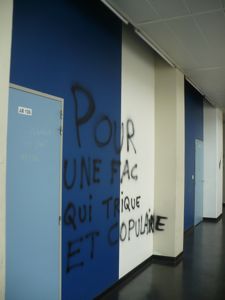
“For a hard and copulating university!”
Continue reading “Militant student slogans and iconography in Toulouse”
Commodification of the sacred in campus landscapes
Kind of amazed to read this article, “The Power of Place on Campus,” by one Earl Broussard, in the Chronicle of Higher Ed (temp link). Striking because it is so obviously a further step in the marketization of every aspect of campus life. The sacred is invoked as a new fund-raising activity. Is this what happens when anthropologists decide to become consultants to college administrators? Broussard writes:
Colleges and universities should never underestimate the power of special, transformational, and even sacred spaces on their campuses… Universities are products of history and tradition. Not only are they institutions of scholarly learning, but they also are sites of memory and meaning, with cultural spaces that have played host to decades or even centuries of ritual.
…Such transformational places with unique emotional resonance have an almost sacred nature. The word “religious” comes from the Latin verb religare, meaning to bind or reconnect. Thus, anything that reconnects us is, inherently, a deeply personal or spiritual experience that has great meaning — and the university campus is ripe with opportunities for people to reconnect.
…Elite universities understand the importance of branding in creating long-lasting loyalty among students, and they use very specific and often-repeated images in such efforts… such imagery typically has very little to do with dormitories, classrooms, libraries, or students working late into the night. Most images focus on the campus as a landscape, with views of special buildings, students walking or lounging on an open green, and, of course, football players or bands performing on the stadium’s holy ground.
So the sacred spaces on campus are something to be branded. Something to be created as a spectacular image that will produce “unique emotional resonance,” that will give us a “deeply personal or spiritual experience that has great meaning.” This Orwellian language deserves, I think, to be stood on its head: “unique” here really means “totally generic,” and “deeply personal” amounts to “totally determined by cunning advertisers.” For there is after all nothing personal in a pre-scripted contact with the sacred, except through the medium of delusion.
Continue reading “Commodification of the sacred in campus landscapes”
Abandoned labs as recycled academic space
If you go into the Enrico Fermi Research Institute on campus, the center doors are made of stainless steel like an old diner. And if you go up the stairs and then down the creaky elevator, you emerge in a warren of white corridors and wooden doors. The basement is full of abandoned science labs, labs that have been empty for ten years maybe, with equipment scattered everywhere, old notebooks, chemical residue, dust, dirt, soot, stacked furniture, whining ventilation. Acids left over in gallon jugs of thick glass. A bottle of wine left as if it had been opened to celebrate the last experiment just before the whole place was summarily deserted. Dark trees shone through the high windows.
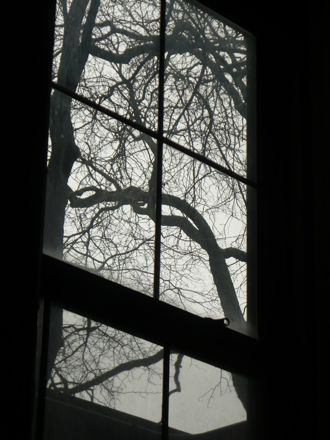

The university is planning to renovate it all, they say, but what with the economic crisis, that might not happen next year. So some of the space has been borrowed.
Continue reading “Abandoned labs as recycled academic space”
The university and skin

this is the university’s skin. at the university of illinois-chicago. some building on the south side of roosevelt road. the branches creeping up across the brick and flung in the sun while the wall is in shadow, the brick stained and blurred and colored, the brick covered by creeping vines, the vines dripping down as if the blood of the bricks were pouring out through the mortar, the snow settled into the vines like cowbirds nesting in places they didn’t build.
Gendered patterns of academic space
Here is a diagram of how students arranged themselves around the room, on the first day of a seminar that happened to be on space and place. It reveals an obviously gendered system of spontaneous spatial organization.
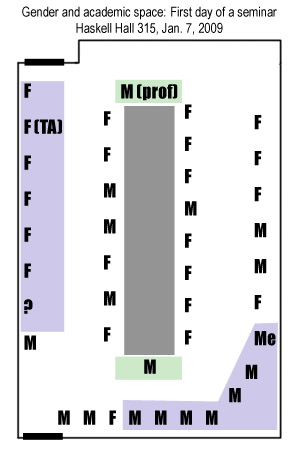
Universities seen through their weeds
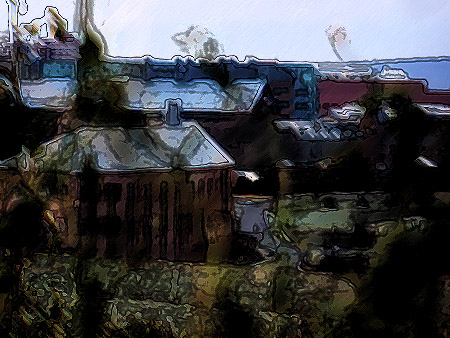
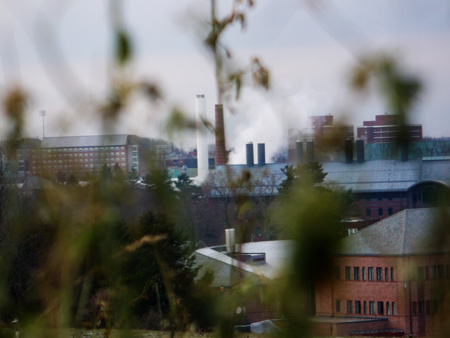
The skyline of a campus is different when it’s obscured by the trudging stalks of its scrub plants.
The university can so easily be made to become a tipsy line drawing mauled by the shadows of leaves and stalks.
Universities and sky 2
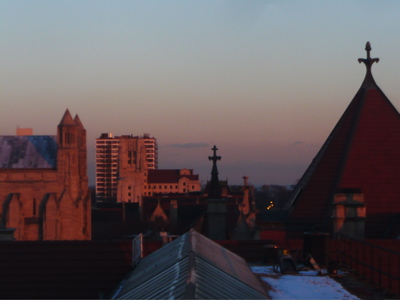
The University of Chicago decorates the tops of its buildings with crosses. They are mostly lost from view, unless you climb to the top of the towers and look out over the rooftops to see them, crosses silhouetted against the sky.
Universities and graveyards
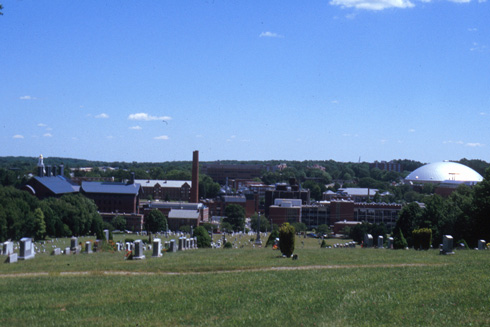
it’s summer in this picture. i was on top of a hill when i took this. i was 18. just before i left for college. the year 2000.
the rows of graves run down the hill to the high brick buildings. the silver dome of the basketball stadium rises like a silly saucer. the trees were the dark green of summer. it was probably hot out.
it’s a little eerie that the view of the university leads down out of a hill of graves. this is the university of connecticut; they have the same thing at cornell university too. a campus graveyard. just a place for the bodies to go when they’re done working, i guess. a convenience, just like the campus coffeeshop. why leave campus when all the amenities are close at hand?
Suspicion and indifference
Universities and night
University and sky
If the campus has a certain relationship with the land, does it also have a relationship to the sky? Does academic space have an upper boundary or a top? Or does it stretch up into the academo-stratosphere (as my friend Jess Falcone puts it) or eventually out into the void where academic “stars” shine?
One of the ways universities organize their peaks is with built objects that rise higher than others, that rise for the sake of rising, because height is symbolically potent: a church, a gilded library cupola, a smokestack, a triplet of water towers, a triplet of flagpoles.
Continue reading “University and sky”
What do the edges of campus look like?
Still not very happy with thinking about the edges of campus either as abject or as sublime, as I discussed the other day. Took some photographs to examine more closely, again of UConn, just past dawn, the day before Thanksgiving.
